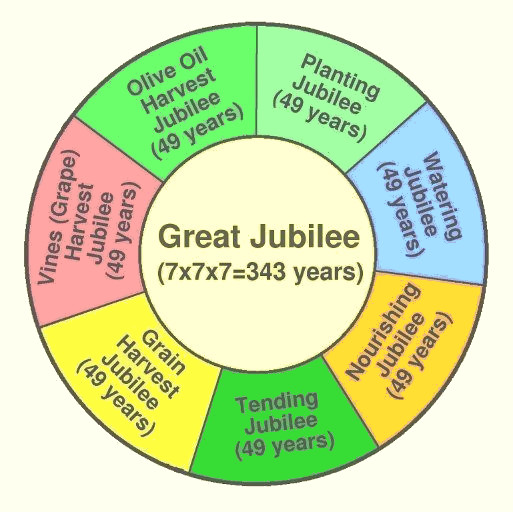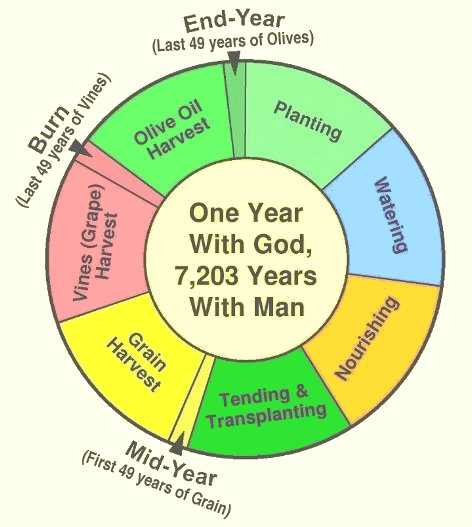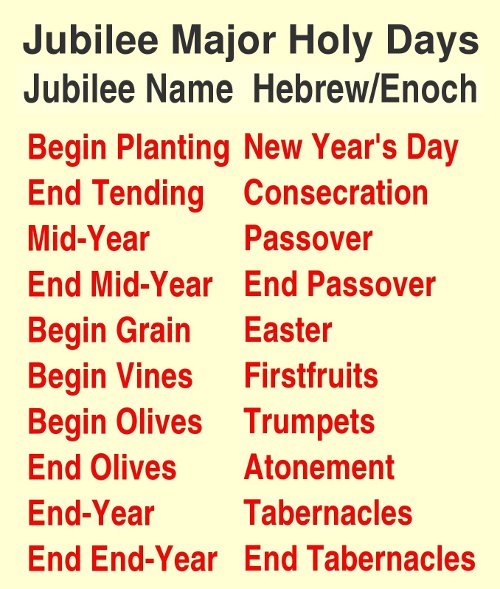
by John P. Pratt
5 Aug 2018, Trumpets (J)
©2018 by John P. Pratt. All rights Reserved.
| 1. Jubilee Calendar |
| 2. Intercalation Pattern |
| 3. New Results |
| 4. Conclusion |
| Notes |
The Jubilee Calendar (J)[1] is a little-known sacred calendar which is derived from its description in the Temple Scroll of the Dead Sea Scrolls.[2] It divides the year into seven agricultural "seasons" of 49 days each. Recently, the method of how to occasionally insert an extra week at the end of the 364-year to keep it aligned with the true solar year has been discovered. The updated pattern has resulted in several known sacred events occurring on holy Jubilee Calendar days. This article reviews Jubilee Calendar basics, describes the leap year pattern and also reports the new results. Readers interested only in the new results can skip Section 2 to avoid technical details, but most would benefit from the calendar overview in Section 1.
 |
The name "Jubilee Calendar" comes from the law of Moses, which specified that years be counted by sevens ("weeks"), with the last being a holy sabbath year. Moreover, those weeks of years were also to be counted by sevens to form a "jubilee" of 49 years (Lev. 25:8-9). The following (fiftieth) year was called the jubilee year, but it was also the first year of the next jubilee, so it was a 49-year cycle.
 |
 |
 |
My first article on the Jubilee Calendar in 2004 showed the annual pattern, emphasized the fact that it was based on divisions into sevens, but nothing was mentioned about when leap weeks should be added to the end of the year. The process of inserting extra days into a calendar year, like 29 February, in order to keep it synchronized with the solar year, is called "intercalation". The intercalation of the Jubilee Calendar done at that time, which has remained acceptable until last week, was a "best fit" to other days known to be holy on the other sacred calendars. It was based on a fixed pattern but not a pattern derived from either scripture or science, as in the case of the spring equinox and new moons being used to intercalate the Hebrew and Enoch calendars. Thus, there has never been strong confidence in some of the resultant dates because of uncertainty of just when leap years should be inserted.
During the past week the key features of the intercalation pattern have been discovered. Not only is the method simple, esthetically pleasing and practical for the layman to often know which years are leap years, but also it produces several more important examples of sacred events occurring on Jubilee Calendar holy days.
When my work began on the Jubilee Calendar, Jewish traditions were consulted about what years were leap years. There was one obvious pattern that seemed as though it should have worked and Jewish tradition agreed. The ancients were well aware of a 28-year solar cycle and some Jewish traditions said it was one way to intercalate years. Remember that the Hebrews counted years by sevens with the seventh being a sabbath year where fields were not planted to let the ground rest also (Lev. 25:3-4). They have accurately maintained the seven-year count ever since they returned from the Babylonian exile in the sixth century BC, and many orthodox Jews still let their fields lay fallow in sabbath years. The Hebrews have, however, lost the jubilee count and hence are unsure of just which years are jubilee years. The answer is that the jubilee year has been shown in my work to be that Jesus Christ was born in a jubilee year. Counting from that year (1 BC) every 49th year is a jubilee year which begins in the previous autumn.
 |
There were Jewish traditions that at one time every sixth year was a leap year, so tradition and science seemed to agree with this concept of basing leap years on the 7-year count. The traditions said the FRIDAY years were chosen to be leap years (all capital letters refer to years rather than days). That was so that SATURDAY (sabbath) years and SUNDAY years (which could be jubilee years) would not be lengthened, thus not extending the time of not being able to work in the fields and vineyards to produce food. That sounds fine, but to me there was one huge problem with that system: God was clearly not using it to schedule religious events! Thus, alternative solutions were sought until one appeared to work very well. Indeed it has remained intact until now, but it was not an elegant pattern, nor did it honor sabbath years, but treated them like any other. It merely was a model which gave what appeared to be mostly correct answers.
Here are the basic elements of what now appears to certainly be the correct pattern. Intercalation is based on the jubilee into which 9 leap years appear in the same positions in every jubilee cycle, except that the last leap year is skipped in one out of three jubilees. Like the Hebrew tradition, FRIDAY years are often leap years and SATURDAY and SUNDAY years never are. The grouping of jubilees into sets of three is similar to how Great Jubilees are grouped into threes and the year has three parts. Three such jubilees result in an average year length of 365.238 years in 147 years, which is closer to the true value of 365.242 than is the Julian year of 365.25 days!
Then seven 147-year cycles are grouped into one millennial jubilee of 1,029 years and the ninth leap year of the last jubilee is not skipped. This leads to an average year of 365.245 days, which appears to be accurate enough to use for all 7,203 years.[5] This pattern is a little tricky, but compared to all my other efforts it is simple, elegant, honors sabbath years, and requires only one year to be a leap year or not.One feature is that it is clear that not every FRIDAY is a leap year. Why not, when nine leap years are needed in the seven weeks of years? Wouldn't that be a nice pattern, similar to the first one tried, where every FRIDAY was a leap year? To me that concept is not used because the Lord loves variety! Every other sacred calendar known to me does not use the simplest, most obvious intercalation system, apparently because it is boring and less flexible! Other calendars have frequent long stretches with no leap years in the sequence. If every FRIDAY year were a leap year then the longest string of years without a leap year would be six. The Jubilee Calendar has some of the seven weeks of years with a FRIDAY leap year, but others allow up to ten years in a row with no leap year. That permits a given holy day to cover a wide range of dates in the solar year. For example, the burning of Solomon's temple occurred on 24 July 587 BC, but the burning of the second temple was 10 days later in the solar year on 3 Aug AD 70, and yet both were on Begin Burning (Jubilee). That 10-day interval was needed because both temples were also burned on the same day on the Hebrew Calendar, which can vary over a full month in the solar year.
It is amazing that such an accurate intercalation pattern can coincide with the pattern by which the years are named. In other sacred calendars the intercalation scheme is totally separate from the year naming pattern. Moreover, in other calendars the intercalation does not begin when the calendar years begin. One reason it took so long to discover this pattern was that I did not believe it was possible for the intercalation and naming to be able to coincide! The fact that this system works is strong evidence that the sun-earth system was created to fit this pattern of sevens. Then, when it is seen how often sacred events occur on its holy days, there is no room for doubt that it was all created as a magnificent celestial time piece.
Now that most of the intercalation details of the Jubilee calendar are known, let's look at some new results.
Most former results have remained unchanged because most years are not near the extremes where leap years are needed. The few dates which have been changed have only been moved by one week, but that difference can be meaningful. It is useful to note that all ten major holy days on the Hebrew Calendar have an equivalent sacred day on the Jubilee Calendar. In this article the more commonly recognized Hebrew holy day names are also used for the day name (See Figure 5). For references for how the following event dates were originally derived, such are provided in my Religious Chronology on my website.
 |
A series of dates which did not change with the update but which were governed mostly by the Jubilee Calendar occurred during the Great Deluge. That was the great Watering of the Earth, the key event of that entire millennium which is named Watering. The Flood lasted an entire year, which year was located in the Great Jubilee named Watering and also in its jubilee named Watering! The exact day on which the rain began is given in scripture (Gen. 7:11), and it was on the day zero of the annual Watering season![6] The day the ark rested on Mt. Ararat in their new home in Turkey was on End Transplanting (Gen. 8:4), the land dried on Atonement (Gen. 8:13), and they exited the ark after exactly one year on the Jubilee Calendar from when the rain began (Gen. 8:14-16). Now the reasons can clearly be seen for why those precise dates would have been included in the revelation of the Book of Genesis. That record is not a collection of campfire stories as modern scholars suggest, nor was it the product of the mind of Moses! The account of the Flood is true history of an earth-changing event which few today in this prophesied age of scoffers believe actually happened (2 Peter 3:3-6).
 |
Another subtle but important change was the day on which Pharaoh awoke to the fact that he had allowed all the slaves to leave and arose to address the issue. Formerly that fell on Passover, which at first blush sounds appropriate. Wrong! It has been shown that part of the whole Exodus ritual was that the slave holders had to be put to sleep, then the slaves escape, and then the slaveholder leader awakens and chases them until the Lord stops him.[7] That strange string of events happened twice in the Book of Mormon, once to Limhi and once to Alma, which might appear rather weird. After Alma's people had made a clean get away from sleeping guards, he must have been surprised that the Lord allowed the guards to awaken and chase them. Couldn't they have slept longer? But the Lord assured Alma that he only had to get past a certain valley at which point He would stop their pursuers (Mosiah 24:23), even as He stopped the Egyptians at the Red Sea! The Lord seemed to be acting out a play or ritual!
So what is all of that about sleep and awakening in the ritual? In each case, the leader awakened and arose on Easter Sunday, the day to awake and arise from the sleep of death! The Exodus was the archetype of this ritual. The Exodus was on a Thursday Passover, the Pharaoh awoke on Sunday, and the Red Sea was crossed on End Passover at the end of Passover week. On the Hebrew Calendar, that means that Pharaoh awoke on Easter Sunday, the Sunday after Passover (which is when Christians usually hold Easter). So we see that Pharaoh should not have awakened on Passover (J), but rather a week later on Easter (J). Now that has been corrected: Pharaoh arose on Easter Sunday morning (J)! What is this ritual symbolic of? It appears to all represent when the captives in the spirit prison were delivered by the Savior on Passover and then they resurrected with the Savior on Easter Sunday! So indeed the awakening is an important part of the ritual!
Another series of dates which did not change but are worth noting occurs at the end of the forty years of the Israelites in the wilderness when they entered the Promised Land. The brazen serpent was lifted up on the Day of Atonement (J), the Book of Deuteronomy began to be given at End Watering (J) (water can represent knowledge or living water), they crossed the Jordan River into the Promised Land on End Transplanting (J) and then the first fruits of their conquest of Canaan occurred when the walls of Jericho fell on Firstfruits (J). The fall of Jericho was also on Firstfruits (Feast of Weeks) on the Hebrew Calendar, which too has that holy day occur after seven special weeks. Moreover, it was Firstfruits on the Priest Calendar. That could explain the very strange part of the story about the seven priests marching around the city daily for seven days and even seven times on the seventh day. So that is seven priests circling the city seven times (Joshua 6:4). That seven times seven could certainly be tied to the seven weeks of seven days leading up to Firstfruits! These are excellent examples of how these events can be orchestrated to have profound symbolism.
Another pair of dates which both changed by a week were the death dates of Abraham's wife Sarah and of the Virgin Mary. Before, both died on the Great Day of the Feast of Tabernacles which tended to link them together. That is a major holy day and was not questioned. But now both dates are a week earlier on the Day of Atonement (J). That has more meaning because Sarah's death was also on the day on which Isaac was offered to be a sacrifice by Abraham. That day was also Atonement on the Hebrew Calendar, which is a day to be reconciled with God. Thus, that appears to be an even better fit. As for Mary, her death was in the final year of the Meridian Jubilee, which is especially sacred. The last year is represented on the Jubilee Calendar as in the week OLIVES and also is the year OLIVES. The annual day of Atonement on the Jubilee Calendar is in the season Olives, the week Olives and the day Olives. The shorthand notation for this day is OO ooo (J). Thus, it is a major alignment which only occurs on one day every 49 years, and in her case, it happened right at the close of the Meridian Jubilee in which Christ came (see Figure 4). The day Moses raised the brazen serpent which represented Christ was also OO ooo (J), and also was a day to be reconciled to God. Thus, the shift by one week of what both death dates are called on the Jubilee Calendar seems significant.
First the basics of the Jubilee were reviewed, noting that its pattern works for both the year and also for seven millennia of history. Then the recently discovered intercalation pattern for the Jubilee Calendar was briefly described. It is essentially fixed in the jubilee cycle and honors sabbath and jubilee years by never having them be leap years. The updated method resulted in the dates of a few religious events being adjusted by one week on the Jubilee Calendar. In most cases any changes caused were significant improvements over the previous results. Examples of such improvements were discussed, all with an eye to more fully appreciating these amazing interlocking sacred calendars and seeing more witnesses of the truth of the revelations of God.